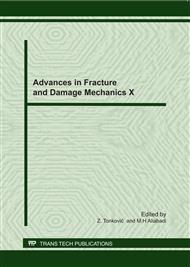p.747
p.751
p.755
p.759
p.763
p.767
p.771
p.775
p.779
A Novel Methodology for Fatigue Delamination Growth Analysis of Composites
Abstract:
A novel methodology for analysis of fatigue delamination growth, capable of dealing with complex delamination shapes and mixed-modes in a computationally efficient way, is proposed. It combines the VCCT to find the energy release rates and the XFEM to update the geometry during the progressive failure, thus making it very robust and computationally efficient. The methodology is demonstrated at coupon level.
Info:
Periodical:
Pages:
763-766
Citation:
Online since:
September 2011
Authors:
Keywords:
Price:
Сopyright:
© 2012 Trans Tech Publications Ltd. All Rights Reserved
Share:
Citation:


